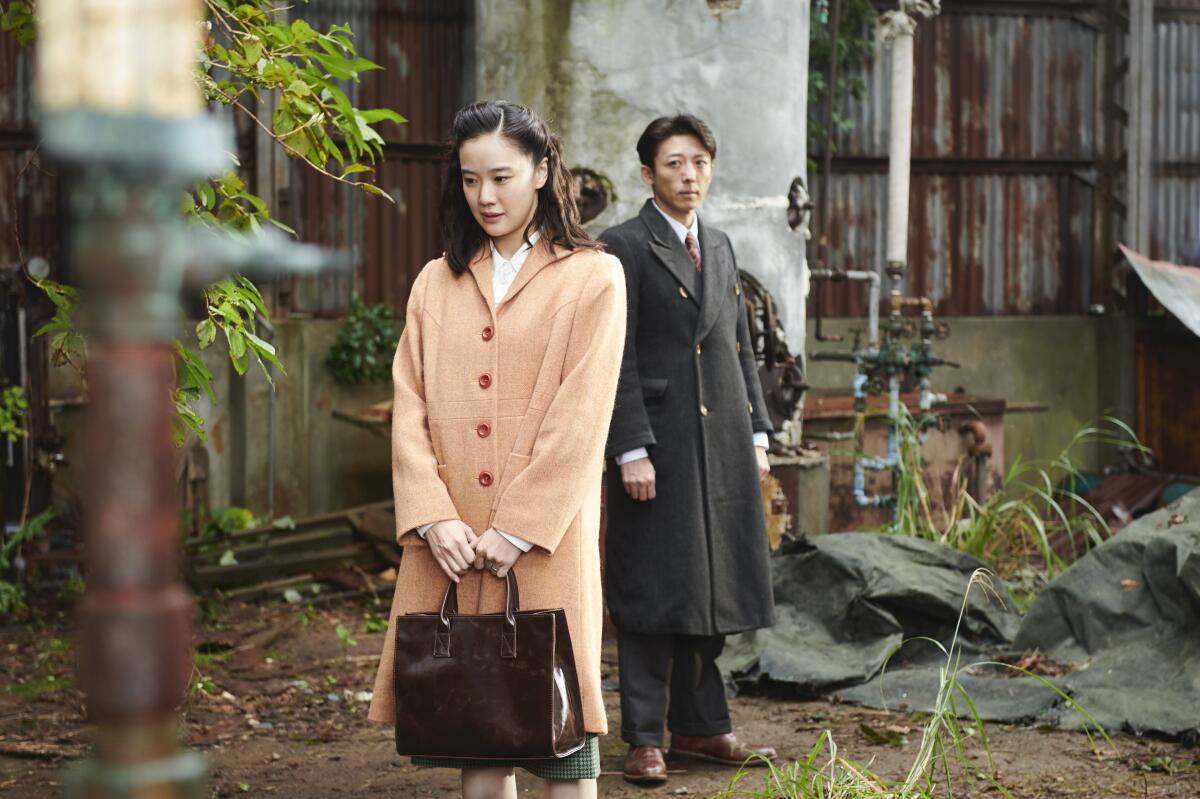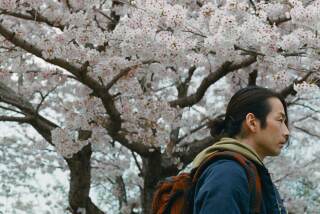Review: Amid melodrama, Kiyoshi Kurosawa’s ‘Wife of a Spy’ assails nationalism

The Times is committed to reviewing theatrical film releases during the COVID-19 pandemic. Because moviegoing carries risks during this time, we remind readers to follow health and safety guidelines as outlined by the Centers for Disease Control and Prevention and local health officials.
With “Wife of a Spy,” a melodramatic wartime period piece, prolific Japanese horror director Kiyoshi Kurosawa, known for balancing psychological thrills with introspective meditations, is discovering a different, more mysterious ground.
Taking place in 1940 Kobe, Japan, “Wife of a Spy” follows Yusaku (Issey Takahashi), an enigmatic businessman, and his trophy wife, Satoko Fukuhara (Yu Aoi), during World War II. Satoko’s childhood friend Taiji (Masahiro Higashide), now a squad leader in the military police, suspects Yusaku of treason because of his deep ties with John Fitzgerald Drummond, an Englishman ostensibly busted for trading in illegal silk but suspected of espionage.
The exacting period detail by production designer Norifumi Ataka further elucidates Taiji’s suspicions. In a Japan rejecting Western customs to support local traditions, Satoko and Yusaku are living in a Western-style villa, with European clothes and imported whiskey. Yusaku and his nephew Fumio (Ryota Bando) are also taking copious trips outside Japan. One such expedition takes them to Manchuria, where they uncover the real-life human testing, including vivisection, that the Japanese-backed Unit 731 (though not specifically named) carried out on the local Chinese population.
Beyond this seismic revelation, the great trick to “Wife of a Spy” is Satoko. She doesn’t know about her husband’s dealings, his role as an intermediary between enemy countries or about the secretive woman (Hyunri) he brings back from Manchuria. Rather, Satoko lives in blissful ignorance by enjoying her lavish home and her dutiful servant and starring in the self-produced B-heist movies her husband creates. Similar to other Japanese citizens, she gives her full support to the empire, making “Wife of a Spy” — which borrows narrative elements from Hitchcock’s “Suspicion” — about her political awakening.
Aoi as Satoko shapes her character’s moral journey far beyond the capacity of a dialogue-heavy script co-written by Kurosawa with Ryusuke Hamaguchi (“Asako I & II”) and Tadashi Nohara. Initially, Satoko behaves with timidity. In a dining room scene, for example, she questions her husband about his trip to Manchuria. The restraint on her face and in her body, as though taped tightly, speaks to her internal conflict. Later, when she discovers the truth, her disposition flips to Machiavellian heights. This inverted personality doesn’t altogether track: How the once gilded housewife disposes of a loved one without hesitation isn’t convincing. But the nimble Aoi makes the unbelievable switch work.
Kurosawa initially fashioned “Wife of a Spy” as a television movie, and it intermittently shows. Japanese broadcaster NHK asked for the film to be shot on 8k digital, rendering the period drama with a crispness that aesthetically looks out of place. The sets are also too large, revealing the film’s sound stage artifice. In one scene, which takes place on the hull of a ship, the space captured is so wide that the setting has a generic look and feel. Here, the lone American actors, two side characters occupying the ship, are near-comical in their terrible acting. While the exaggerated performances are intended, they diffuse the heart-racing scene of any drama.
While “Wife of a Spy” labors as a melodramatic mystery, it swims as a cautionary tale about rampant nationalism. Taiji, for example, at first a good-natured guy, turns monstrous to defend the empire. Much of the violence happens off-screen: But a torture scene adds jagged edges to this tranquil period drama, while the footage of an internment camp and its prisoners adds deeper, visceral warnings. The elongated scenes, relying on acute blocking and measured pans, further lock audiences within Kurosawa’s planned tension.
The film’s conclusion leans too closely to the melodramatic. But Kurosawa’s assured direction is enough to make “Wife of a Spy” an enrapturing, stylish wartime period piece.
‘Wife of a Spy’
In Japanese and English with English subtitles
Not rated
Running time: 1 hour, 55 minutes
Playing: Starts Sept. 24, Laemmle Royal, West Los Angeles; Laemmle Town Center, Encino; Laemmle Playhouse 7, Pasadena
More to Read
Only good movies
Get the Indie Focus newsletter, Mark Olsen's weekly guide to the world of cinema.
You may occasionally receive promotional content from the Los Angeles Times.










